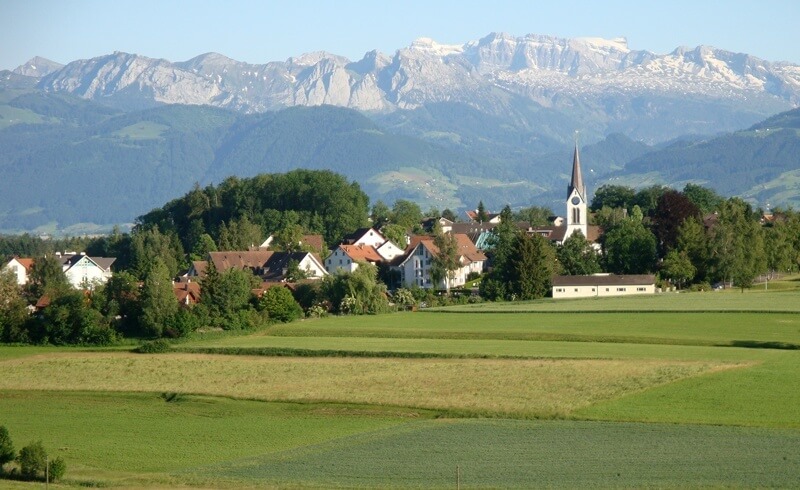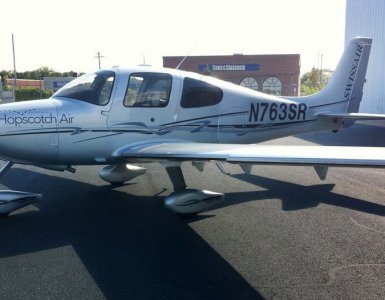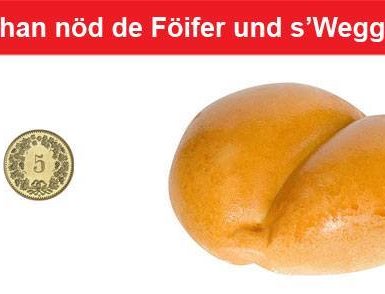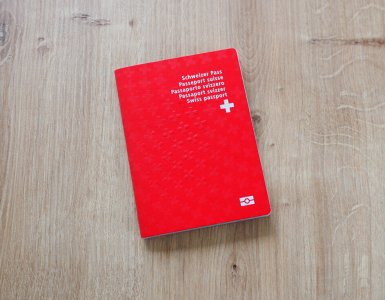Chocolate, watches and Swiss Army knives. If you associate Switzerland with the usual suspects, you are not alone!
Sure, we could go on to show you all kinds of typical photographs that play off these clichés. This would reassure us that there is at least some certainty in this world. In the case of Switzerland, that certainty or stability is called Swissness.
Originally, I wanted to come up with 725 Swiss icons in honor of this year's 725th anniversary. But with Pokémon GO fever in full swing, I decided to spare you the time and focus on just 13 typically Swiss things. Some of these might prompt a stare or deserve a closer look. But most of them will make you exclaim: "That's so Swiss!"
The mountains
This is where many of us are thrown off course: The Alps are not actually the only "mountains" in Switzerland. Instead, other iconic sights include the Jura range, the pre-Alps, or the peaks of Valais.
With Switzerland being so compact, the mountains are even a part of urbanized regions. And thanks to the warm "Föhn" winds that clear the air of any moisture, the Swiss mountains sometimes appear much closer than they are in reality:
Multilingualism
When people hear that I am Swiss, I get the same question over and over: "How many languages do you speak?" They are certainly on to something, because multilingualism is a thing in Switzerland. German, French and English are the basics for most of the population. And Italian is hardly an issue, either, for those who grew up in this country.
But can you guess the language on the top?
The Romansh language
If you guessed Latin above, you were not very far off. It is Rumantsch Grischun, one of Switzerland's four official languages. This variant of Romansh was only introduced in 1982, and it coexists with five other regional dialects: Sursilvan, Sutsilvan, Surmiran, Putèr, and Vallader.
Those living in eastern Switzerland who speak Romansh are part of the Swiss media world as well. Romansh-speaking Switzerland has its daily newspaper, La Quotidiana, available Monday to Friday, and is even part of German speaking Swiss TV with its Cuntrasts show and teletext information in Romansh (from page 790).
Note to all here: The Germans may speak German, the French may speak French, but the Swiss do not speak "Swiss"...
The Swiss German dialect
The same people who can speak Romansh can also speak Swiss German, or Schwiizerdütsch. Despite the lack of spelling and huge regional differences in terminologies, Swiss German is the universal dialect that much of Switzerland uses, day in, day out. The same thing might have entirely different names - even in bordering cantons. (pizAllegra is an interactive website which visualizes these differences.)
In short: From kiosk staff to even newsreaders on regional television stations, and from kindergarten teachers to dentists, Swiss German is how the part of Switzerland known as the Deutschschweiz ticks.
Birchermüesli
Müesli is a health dish that Dr Maximilian Bircher-Brenner concocted for his hospital patients back in around 1900. In this day and age of vegan/vegetarian/health food, it is actually hard to believe that Birchermüesli goes so far back…
These days, Müesli is very much en mode as it is consumed for breakfast, lunch or dinner by many Swiss. It comes in many varieties containing oats, grains, fruits, berries, seeds, and nuts, as well as a base of milk or yogurt.
(Photograph copyright VirtualSteve/Wikipedia)
Rösti
Rösti is a funny creature in the Alpine republic. The term is most often used for the Swiss national hashbrown dish, but it is also a family surname (yes!) and a cultural reference.
The potato dish is usually accompanied by Kalbsbratwurst and Zwiebelsauce (veal sausage and onion sauce). While it is popular across Switzerland, there is less consensus in its political meaning. Röstigraben is a Swiss German term for an imaginary "Rösti ditch". This division often becomes apparent during elections when German speaking Switzerland votes one way - and the French speaking part votes the other.
The Federal Palace in Bern
And while we are on politics, we would be missing the full picture of Swiss icons if it was not for the Federal Palace in Bern.
The public square in front of the palace is remarkably low key compared to those of parliamentary buildings in other countries. In fact, it has a past as a parking lot before it was spruced up. Today, it is a popular space for families with kids: There is an unpredictable fountain which makes for Switzerland's most refreshing playground!
The Heimatort of Swiss citizens
Your claim to Swiss citizenship is validated if you can proof your Swiss roots. Each citizen has a Heimatort, which is sometimes alternatively referred to as a Bürgerort. It is the place of origin where a Swiss has their municipal citizenship. Those who are born in Switzerland to a Swiss parent (or parents) inherit their Heimatort from either the mother or the father, or the parent who is Swiss.
Someone who is naturalized receives their Heimatort connection from the place where their Swiss passport was issued. And the non-Swiss spouse of a Swiss (whether Swiss born or naturalized) becomes Swiss by taking up the Heimatort of his or her Swiss spouse. Got it?
The Heimatort, which is at the municipal (or most local) level is the most crucial part for a non-Swiss on the path to naturalisation. It also replaces the actual place of birth in Swiss identity documents. The significance of the Heimatort, the Swiss place of origin, has waned increasingly in this century. Social assistance is no longer mandatory by law for the Heimatort, and few people have ever lived in their place of origin.
Direct democracy
Swiss citizenship carries with it not just a passport that gets the holder visa-free access to much of the world, but also the right to vote four times a year. (The canton of Schaffhausen is an exception to the rule. There, it is actually mandatory to vote!)
Depending on whether you are a resident or not, the votes can include local issues as well. Examples are local school expansions or tram line extensions. On a national level, issues include key initiatives such as regarding joining (or abstaining from) the EEA or the UN.
If you are resident in the country and you are Swiss, you might easily get a dozen issues to decide on by the federal, cantonal, and municipal governments. This appears to be overwhelming for some - voter turnout remains around 50 percent or below. Although for highly emotional issues, such as the 1992 election on whether or not to join the EEA, more than three-quarters of the Swiss electorate turned up to vote!
Advice from political parties
And the way you should vote on this, that, or the other issue can seem like the worst of contradictions, because one political party suggests you vote in the way that the other party loves to hate!
Nevertheless, the billboards in many Swiss towns in the run-up to an election show direct democracy in action. It is a unique sight in its own right.
Teletext
Whereas in other nations, such as the UK, US, and Australia, the service has come and gone, Teletext remains incredibly alive in Switzerland. It can even be called up overseas on mobile devices, and is in fact one of the preferred ways yours truly stays in touch with news from Switzerland.
A total smorgasbord of content is available on the service: From news and weather forecasts to stock market numbers and flight departure or arrival information. (Alas, the Swiss Federal Railways has terminated their info service on Teletext.)
Swiss typography
Every letter you see in this picture originated from a Swiss typographer. I kid you not: The fonts you spot here are all Swiss inventions, including Helvetica, Univers, Frutiger, and even OCR-B.
Switzerland's road signs, government logo, and even its very own passport, utilize almost exclusively Swiss fonts. The late Adrian Frutiger brought upon this world such classics including Univers, Frutiger, and Avenir.
Hiking paths (65'000 km of them)
In China, the new craze is about WeChat Footsteps, which allows users of the social network to like people based on how many steps they have clocked in. On foot, day in, day out.
How do you claim pole position in this game? Simple: Walk - ideally on and on, just like the Energizer Bunny! Fortunately, doing so is a breeze in Switzerland if you explore the country on its huge network of Wanderwege, or hiking paths. The paths marked in yellow are accessible for all and pose minimum problems. The tougher mountain trails are signaled in white-red-white paint, or for particularly challenging paths, white-blue-white.
And with many of these signs, you get your average hiking time to the next destination in minutes, as well as the elevation in key "meeting points". This is so you know how much "higher" you need to climb before reaching Matterhorn-like elevations...
While a Beijinger might struggle finishing 10,000 steps in a day, their counterpart in Bern has few problems doubling up on this number. This is thanks to the Swiss city planning which promotes walking (Wandern in German) - and a national obsession with even the leisurely evening stroll. In fact, Wander-ing associations exist throughout the country!





